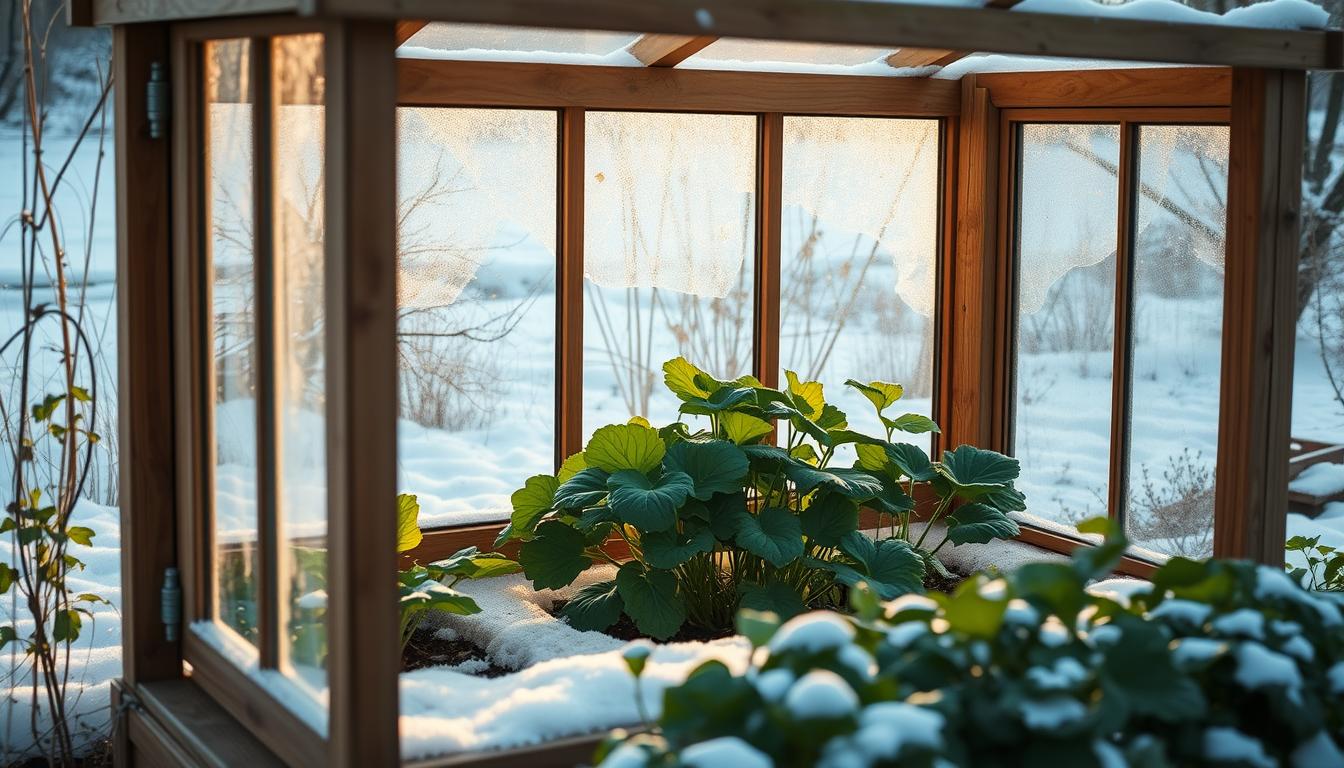Imagine picking fresh lettuce in January or starting seedlings weeks before your neighbors. This isn’t garden magic – it’s cold frame gardening. These structures let you grow more, even in tough climates.
These mini-greenhouses are great for both new and experienced gardeners. You don’t need fancy tools or special skills to start. Just basic materials and a wish to grow food longer.
The benefits are quick and rewarding. Enjoy crisp greens in the snow, give seedlings an early start, and keep fall crops safe from frost. This guide will show you how to make your garden productive all year.
Ready to go beyond traditional growing limits? Discover how cold frame gardening can change your garden’s potential. Keep your kitchen full of fresh, homegrown food all year.
The Magic of Season Extension
For passionate gardeners, the old growing season limits have always been a problem. In most of America, you can only garden for a few months a year. The rest of the time, your garden is empty, and your grocery bills go up.
Season extension techniques change this. They let you grow plants for weeks or months longer. These methods work with nature, keeping plants warm and safe from harsh weather.
Why Gardeners Need Extended Growing Seasons
The old growing season limits gardeners a lot. In northern states, you might only have 4-5 months without frost. Even in milder places, extreme weather can limit when you can plant.
Extended growing seasons let you grow more all year. You can have multiple harvests, not just one in summer. This means less money spent on store-bought veggies and better nutrition.
Season extension also makes gardening more rewarding. It keeps you connected to the soil and growing things all year. Enjoying fresh greens in January or planting early is incredibly satisfying.
How Cold Frames Transform Your Garden Calendar
Cold frames are a standout for extending the season. They create a warm spot for plants, making them think it’s warmer than it is. The top lets in sunlight, and the sides keep in heat, making it 5-10 degrees warmer.
This makes a big difference in your garden. You can start seedlings 3-4 weeks early in spring. Fall harvests go longer, and winter can be a growing season too, with crops like spinach and kale.
Cold frames are easy to make and need little upkeep. They can be built in a weekend and give you months of extra growing time. They’re great for gardeners of all levels who want to grow food all year.
Understanding Cold Frame Gardening
Cold frame gardening is a way to grow food all year round. It’s a simple yet powerful method that has been used for generations. This technique helps gardeners grow fresh food even when it’s cold outside.
Before we get into the details, let’s talk about what cold frames are. They are structures that protect plants from bad weather. They let sunlight in, creating a warm spot for plants to grow.
What Exactly Is a Cold Frame?
A cold frame is like a mini greenhouse. It has a frame and a clear top. The frame can be made of wood, brick, or plastic. The top is usually glass or polycarbonate.
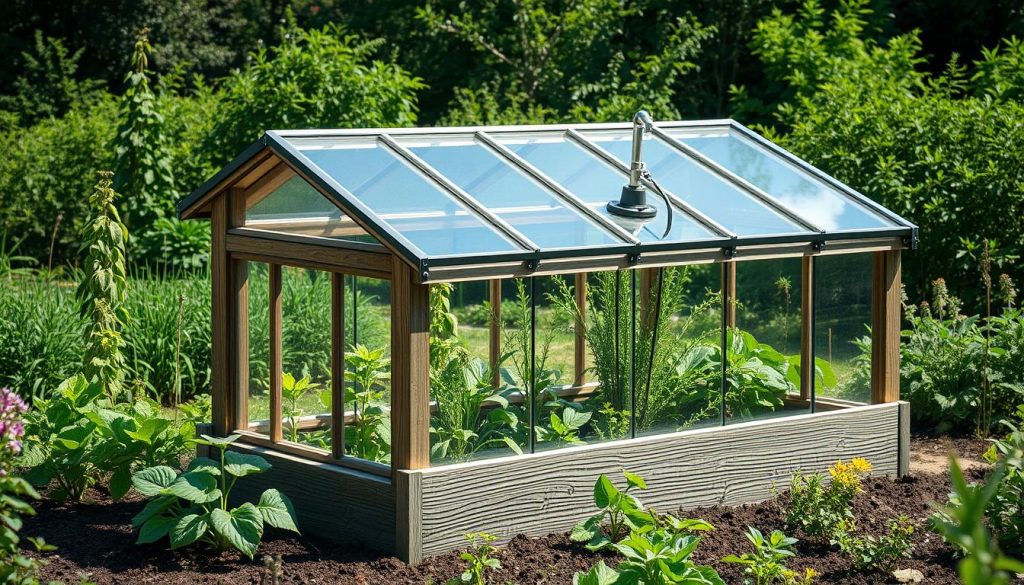
These frames trap sunlight during the day. At night, they slowly release it, keeping plants warm. This makes a cozy spot for plants to grow, even when it’s cold outside.
There are many types of cold frames. You can find:
- Fixed frames built into garden beds
- Portable boxes that move with the seasons
- Lean-to designs that attach to other structures
- Models with adjustable vents
The Historical Journey of Protected Cultivation
Protected gardening has been around for a long time. Ancient Romans used mica to grow cucumbers for Emperor Tiberius in 30 AD. They found that even a little protection made a big difference.
In the Middle Ages, Europeans used cloches to protect plants. These early covers helped plants grow faster. By the Renaissance, gardeners were using more advanced systems.
The Victorian era was the peak of cold frame gardening. Big estates had elaborate cold frames. These showed off the owner’s wealth and gardening skills.
Today, cold frames still work the same way but with better materials. They show that simple ideas can be the most effective.
Benefits That Make Cold Frames Worth It
Cold frame gardening brings many rewards beyond just protecting from frost. These structures turn ordinary gardens into productive spaces all year. They are great for both new and experienced gardeners, offering many benefits.
Harvesting Fresh Produce Year-Round
Imagine picking crisp lettuce for your lunch in January. Cold frames make this possible. They create a warm spot in your garden, extending the growing season.
Vegetables like spinach and kale grow well in cold frames. They taste better than store-bought, with more nutrients.
Vegetables taste sweeter after a light frost. This is because plants turn starches to sugars in cold weather. This makes your homegrown veggies taste amazing.
Saving Money on Grocery Bills
Using a cold frame can save you money. A 4′ x 8′ frame can grow enough greens to save $15-25 a week in winter. This adds up to a lot of savings over a year.
Building a basic cold frame costs $50-150. But, you can make back this money in just one season.
You can also grow specialty crops at home. These can sell for $5-8 a pound at markets. But, they cost almost nothing to grow yourself.
| Cold Frame Benefit | Spring Value | Summer Value | Fall Value | Winter Value |
|---|---|---|---|---|
| Season Extension | 4-6 weeks earlier planting | Seedling protection | 4-8 weeks longer harvest | Year-round growing possible |
| Crop Protection | Frost protection | Pest barrier | Weather buffer | Complete frost protection |
| Financial Savings | Early crop premium | Seedling cost savings | Extended harvest value | Off-season produce savings |
| Environmental Impact | Reduced plant loss | Lower water usage | Extended local growing | Minimal energy consumption |
Environmental Benefits of Local Growing
Cold frame gardening is good for the planet. Store-bought produce travels 1,500 miles, using fossil fuels and causing emissions. Growing your own food cuts down on these impacts.
Cold frames also use less water. They trap moisture, saving up to 80% of water compared to open gardens. This is great for areas with little water.
Cold frames use the sun’s energy, not electricity. They protect plants without using extra resources. This makes them a sustainable choice for growing food at home.
The Science Behind Cold Frames
Cold frames work because of science. They use sunlight to make a warm spot for plants. This spot can be 5-10°F warmer than outside. Knowing how they work helps gardeners grow more plants.
How Solar Energy Is Captured and Stored
Cold frames trap heat like a greenhouse. Sunlight enters through the top and plants absorb it. Then, the plants send out heat as infrared radiation.
The top of the cold frame lets sunlight in but keeps heat in. This makes the inside warm. It’s like a one-way door for energy.
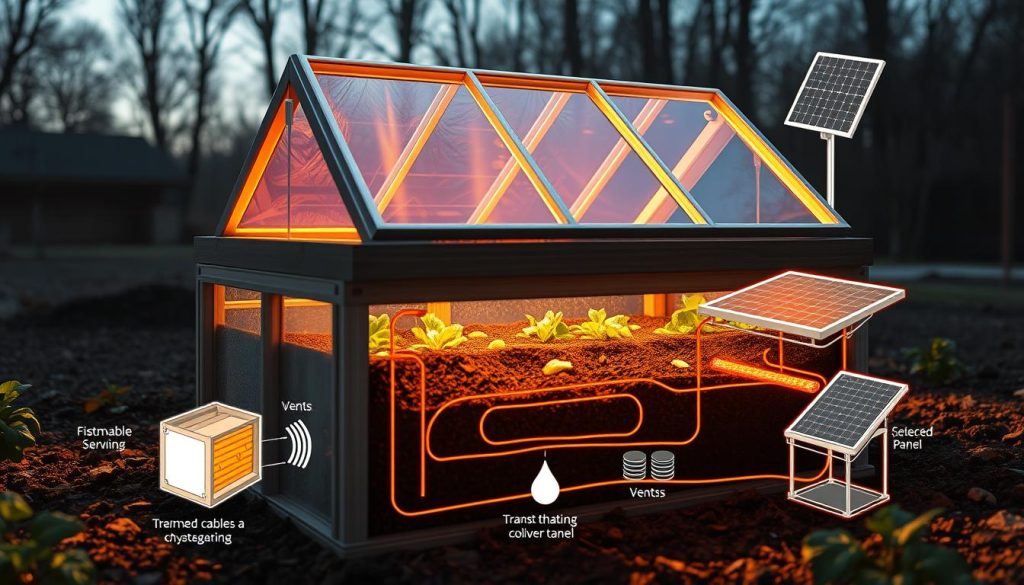
Inside the cold frame, materials like soil store heat. They release it slowly at night. This keeps the temperature stable.
| Thermal Mass Material | Heat Storage Capacity | Release Rate | Best Used For |
|---|---|---|---|
| Dark Soil | Medium | Medium | General growing medium |
| Water Containers | High | Slow | Overnight temperature regulation |
| Stone/Brick | High | Medium-Slow | Back walls for heat reflection |
| Metal | Low | Fast | Quick daytime warming |
Soil Warming Mechanisms and Plant Protection
The trapped solar energy warms the soil. This keeps plant roots active. Even when it’s cold outside, the soil is warm enough for growth.
Warm soil is good for plants. It keeps microorganisms working and roots growing. Seeds germinate sooner in spring and fall crops last longer.
Cold frames also protect plants from frost. They block harsh winds and keep humidity high. This reduces stress on plants during dry winter months.
Cold frames make growing possible for longer. They warm the soil and protect plants. By understanding this, gardeners can grow plants all year.
DIY Cold Frame Construction
You can build a custom cold frame with basic tools and materials. It fits your garden’s needs perfectly. This way, you save money and tailor it to your growing goals. You don’t need advanced woodworking skills to make a great growing space.
Essential Materials and Tools
First, gather all the supplies you need for a smooth build. The materials you pick will affect your cold frame’s durability and heat retention.
- Lumber: Untreated cedar or redwood (resistant to rot) for the frame
- Transparent covering: Old windows, polycarbonate panels, or heavy-duty plastic sheeting
- Hardware: Hinges, screws, corner brackets, and optional automatic vent openers
- Weatherproofing: Silicone caulk, weather stripping, and wood preservative
- Tools: Measuring tape, circular or hand saw, drill with bits, screwdriver, level, and square
A 3′ x 6′ cold frame costs between $50-$150, depending on materials. Using reclaimed materials can lower costs. Quality transparent covering improves insulation and longevity.
Step-by-Step Building Process
Building your cold frame has two parts: the base and the transparent lid. Breaking it into stages makes it easy for beginners.
Begin by cutting lumber for a rectangular base with a sloped top. The front should be 8-12 inches tall, and the back 12-18 inches. This angle helps rain run off and lets in more light in winter.
Assemble the sides using corner brackets or screws. Make sure corners are square and the frame is level. Some gardeners add a bottom, but leaving it open helps roots grow.
Lid and Hinge Installation
The lid is crucial for controlling light, heat, and ventilation. If using an old window, build your frame to fit it perfectly.
Attach the lid to the back with sturdy hinges. Use at least two hinges for stability. Add a handle for easy lifting. Consider a prop or automatic opener for ventilation on warm days.
Seal all joints with caulk to prevent heat loss and protect from moisture. This step greatly improves temperature inside your cold frame.
Upcycled and Budget-Friendly Options
You don’t need to buy new materials to make a cold frame. Creative gardeners can use common items to build useful spaces.
- Salvaged windows or glass doors make perfect lids with built-in frames
- Clear plastic storage bins can be transformed into mini cold frames with minimal modification
- Straw bales arranged in a rectangle with an old shower door on top create temporary seasonal protection
- PVC pipe frames covered with greenhouse plastic offer lightweight, movable options
- Brick or concrete block walls provide thermal mass and can be arranged to support a transparent cover
Even plastic milk jugs with bottoms removed can protect plants like mini cold frames. The key is a clear barrier that traps solar energy. With some creativity and basic skills, you can extend your growing season without spending a lot.
Strategic Placement for Maximum Results
Getting your cold frame in the right spot is key to its success. Even the best cold frame won’t work well if it’s in the wrong place. Where you put it affects how warm it stays, how plants grow, and how long you can grow things outside.
Optimizing Sun Exposure and Angle
In the Northern Hemisphere, facing south is best for catching sunlight in winter. Watch your garden to see where the sun hits most. This is important for morning and midday sun, when it’s most useful.
The angle of your cold frame lid is also important. A 5-7 degree slope lets in the right amount of light and keeps rain and snow off. You can get this angle by making the back wall taller than the front.
Change how you place your cold frame with the seasons. In spring, east-facing is good for gentle sun. But in winter, you need full south exposure to keep plants warm.
Protection from Wind and Weather Elements
Wind can steal heat from your cold frame. Place it near things like shrubs or fences that block wind but don’t shade your plants. If you can’t find natural barriers, use straw bales or fencing.
A south wall of your house or garage is great. It blocks wind and keeps warm, helping your plants grow longer.
Don’t put your cold frame in low spots where cold air and moisture collect. Make sure it’s on ground that drains well and is easy to get to in winter. You don’t want to have to wade through snow to get to your plants!
Seasonal Cold Frame Gardening Guide
Cold frame gardening is great for all seasons. It’s not just for spring and fall. By adjusting your cold frame for each season, you can grow food all year.
Spring: Hardening Off Seedlings
Spring is when your cold frame is most useful. It helps seedlings get used to the outdoors. This is called hardening off.
Start seedlings in the cold frame for 2-3 hours on the first day. Increase the time over 7-10 days. This protects them from wind, frost, and rain while they get sunlight.
Watch the temperature closely. On sunny days, the inside can get hot. Open the lid by mid-morning. This helps seedlings grow strong before they go into the garden.
Summer: Managing Heat and Shade
Cold frames are useful in summer too. They can provide shade instead of trapping heat. Use shade cloth to block 30-50% of sunlight.
They’re great for plants that like humidity, like basil. They’re also good for starting fall crops in late summer. This helps seeds grow well, even when it’s hot outside.
Summer cold frames need good ventilation. Open the lids or remove them on hot days. Some people use solar fans to keep air moving and prevent mold.
Fall: Extending Your Harvest Season
In fall, your cold frame helps you grow longer. Start moving summer beds into cold frames 4-6 weeks before the first frost. This lets plants grow well before it gets cold.
Plant quick-growing crops like lettuce and radishes. They can be harvested before winter. For existing plants, a cold frame can make them last 4-6 weeks longer.
Fall is also good for planting overwintering crops. These plants grow in early spring. Garlic, onions, and spinach planted in fall often grow better than those planted in spring.
Winter: Growing Cold Hardy Vegetables
Winter gardening in cold frames is for hardy plants. Spinach, mâche, kale, and some Asian greens grow well in cold, low light. They can grow even when it’s just above freezing inside.
Winter growth is slow. Plants may only grow a few leaves a week. But these leaves are sweet because of the cold. Harvest leaves one at a time to encourage more growth.
Insulation is key in winter. Use straw, bubble wrap, or water containers to keep the frame warm. On sunny days, vent the frame by noon to avoid overheating.
| Season | Primary Function | Key Management Tasks | Best Crops |
|---|---|---|---|
| Spring | Hardening off seedlings | Gradual exposure, temperature monitoring | Transplants, early lettuce, radishes |
| Summer | Shade and humidity control | Ventilation, shade cloth installation | Fall seedlings, heat-sensitive herbs |
| Fall | Season extension | Frost protection, reduced watering | Leafy greens, root vegetables, herbs |
| Winter | Cold protection | Insulation, limited watering, snow removal | Cold hardy vegetables, spinach, mâche |
Top Performers: Vegetables That Thrive in Cold Frames
Discover the vegetable superstars that shine in cold frames. They let you harvest fresh produce even in the coldest months. Choosing the right plants is key to a successful harvest.
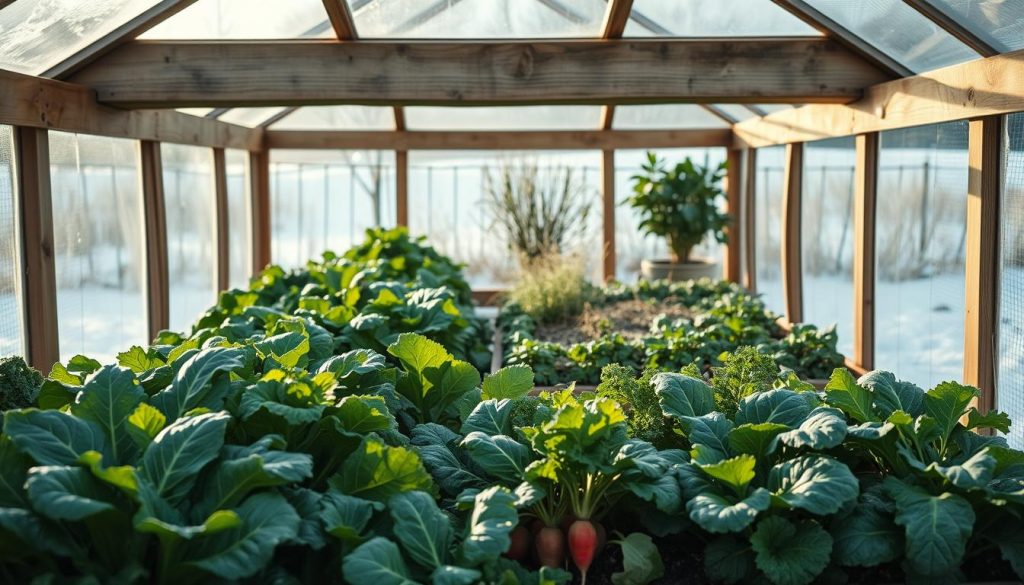
Leafy Greens for Year-Round Harvests
Leafy greens are winter gardening’s top stars in cold frames. ‘Winter Density’ lettuce stays crisp in near-freezing temps. ‘Tyee’ spinach grows back fast after you cut it.
‘Winterbor’ kale gets sweeter with frost. This is because cold turns starches into sugars, making it taste better. Plant these greens in succession from late summer to fall for a steady supply.
These greens can handle temperatures as low as 20°F (-6°C) in a cold frame. This means you can keep harvesting long after outdoor gardens freeze.
Root Vegetables That Love Protected Growing
Root vegetables act as living storage in cold frames. They stay in the soil until you’re ready to eat them. ‘Napoli’ carrots and ‘White Icicle’ radishes stay crisp and sweet.
‘Hakurei’ turnips grow fast, letting you plant them multiple times. Plant them by late summer or early fall to grow big before it gets too cold.
The soil in a cold frame keeps root zones warm. This lets you harvest as needed through winter. It’s like having a natural fridge!
Surprising Crops That Excel Under Cover
Some surprising crops do great in cold frames. Asian greens like tatsoi and mizuna grow fast and taste spicy. Plant them in fall for a steady supply.
Cold-tolerant herbs like flat-leaf parsley and cilantro keep producing long after outdoor herbs stop. For an early spring treat, plant ‘Oregon Sugar Pod’ or ‘Snowbird’ peas in late winter. They’ll grow in cool soil and give you sweet pods early.
Even flowers like violas and calendulas do well in cold frames. They add color to winter salads and attract early pollinators on mild days. These unexpected additions make your cold frame more productive.
Essential Maintenance for Lasting Success
Every successful cold frame garden starts with key maintenance steps. These mini greenhouses need less care than big ones but still need attention. Neglecting them can lead to unhappy plants and short harvests.
The good news is that most maintenance tasks are quick but offer big benefits. They help keep your plants healthy and extend your harvests.
Daily and Weekly Monitoring Tasks
Good cold frame gardening means watching your garden closely. Use a min/max thermometer to check temperatures daily. This simple step prevents overheating or freezing.
Also, check the soil moisture by feeling it. It should be damp but not wet. Look for pests or diseases during these checks. Early detection makes solving problems easier and keeps your plants healthy.
Don’t forget to inspect hinges, seals, and covers weekly. This prevents small problems from becoming big ones.
Seasonal Cleaning and Repairs
Each season brings its own maintenance tasks for your cold frame. In spring, clean the transparent coverings well to let in more light for seedlings. Summer is a good time to check and fix any structural issues.
In fall, seal any gaps to keep cold out. Clean out all plant debris and disinfect the inside with a 10% bleach solution. Before winter storms, make sure your frame can handle snow and reinforce it if needed.
Transparent coverings need special care. Clean them gently with soapy water and a soft cloth. Replace any panels that are too cloudy to let in enough light.
Ventilation: The Key to Healthy Plants
Good airflow is crucial to avoid two major problems: too much heat and fungal disease. Even in winter, your plants need air on sunny days when it gets too hot inside.
Manual ventilation is simple: just prop the lid open with a stick or block. For those who are always busy, automatic vent openers are a great choice. They open the lid when it gets warm and close it when it cools down.
The right amount of ventilation depends on the season and weather. On mild spring days, open the frame fully during midday. In winter, a small opening for a few hours is enough. Here’s a helpful guide for ventilation:
| Season | Weather Condition | Ventilation Needed | Best Time | Special Considerations |
|---|---|---|---|---|
| Winter | Sunny, above 40°F | 2-4 inch opening | 10am-2pm | Close before temperatures drop |
| Spring | Sunny, above 50°F | Half open | 9am-4pm | Watch for sudden temperature changes |
| Summer | Hot days | Fully open or remove lid | All day | Consider shade cloth addition |
| Fall | Mild days | Quarter open | 11am-3pm | Monitor first frost forecasts |
Advanced Techniques for Cold Frame Masters
For those who love gardening and want to grow more, these advanced tips can help. You can turn a simple cold frame into a high-tech growing space. As you get better at gardening, your cold frame can too, making it easier to care for.
Integrating Mini Greenhouse Features
Make your cold frame into a mini greenhouse with smart upgrades. Adjustable shelves let you grow more plants in the same space. This boosts your growing area.
Internal dividers help create different temperature areas. This lets you grow both cold and warm plants together. Vertical trellises also save space, great for climbing plants like cucumbers.
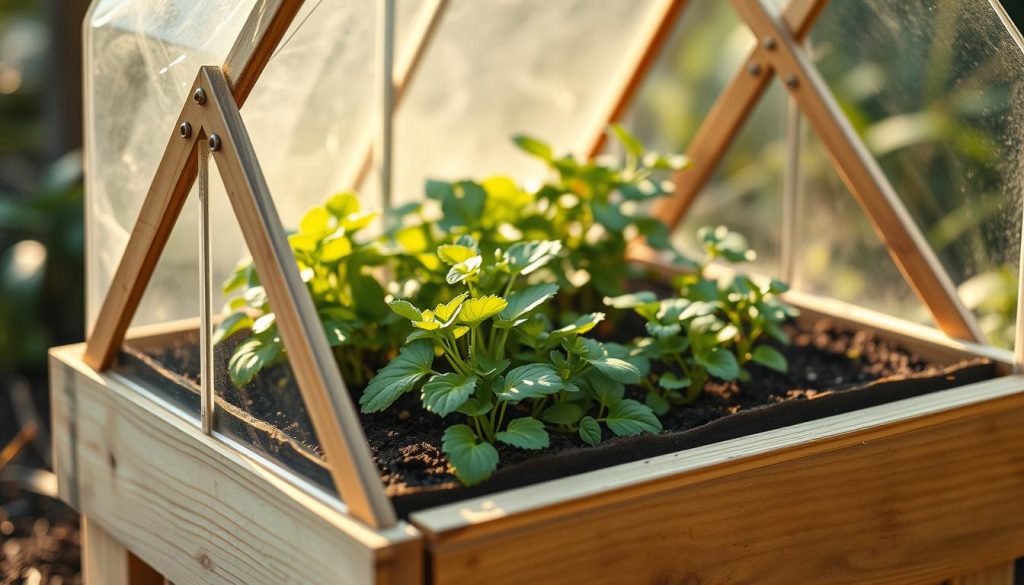
Adding hinged panels is a good idea. They open easily when it’s warm, giving you access while keeping things cozy. These changes cost $25-75 and can almost double your growing space.
Adding Supplemental Heat Sources
Adding heat can make your cold frame work year-round. The best way is using passive heat methods:
- Water-filled black containers that soak up heat during the day and release it at night
- Thermal mass materials like stone or brick that catch sunlight
- Compost heat systems that use the warmth from decomposition
- Soil warming cables that keep the roots warm
For more control, electric options like soil mats (10-20 watts) and small heaters (50-200 watts) work well. Use about 10 watts per square foot to keep it 10°F warmer than outside.
These options cost from $15 for DIY to $100+ for electric. They can extend your growing season by 4-8 weeks in cold areas.
Automated Systems for Busy Gardeners
Modern tech can make gardening easier. Solar-powered vents ($25-40) keep your frame cool when it’s sunny. They work without electricity, using wax that changes with temperature.
Drip irrigation systems ($50-100) with moisture sensors water plants just right. They save water and prevent diseases. For tech lovers, wireless monitoring ($75-150) lets you check on your garden from your phone.
The best setup combines these with timers and smart controllers. It’s almost self-sufficient, needing only weekly checks. While it costs $200-300 at first, it saves a lot of time and improves your garden.
Your Year-Round Growing Journey Begins
Ready to turn your garden into a year-round food source? Cold frame gardening is for everyone, from beginners to experts. It lets you grow food even when it’s snowing and start spring planting early.
You don’t need fancy tools or know-how to start. Build a simple cold frame with old windows and wood, or buy a kit. Put it in a sunny spot, and you’re off to a great start.
Start with crops that fit the season. Plant spinach, kale, and carrots in fall. In spring, use it to toughen up seedlings. Cold frame gardening is all about being flexible and learning as you go.
Success in cold frame gardening means daily care. Make sure it’s well-ventilated on sunny days, water right, and keep an eye on the temperature. This creates the best environment for your plants.
Picture this: picking fresh greens in January or digging up veggies while others’ gardens are still asleep. It’s more than gardening; it’s a way to live sustainably. It connects you to old growing traditions, saves money, and helps the planet.
Your cold frame adventure begins now. Take that first step, and see how your growing season can grow.

